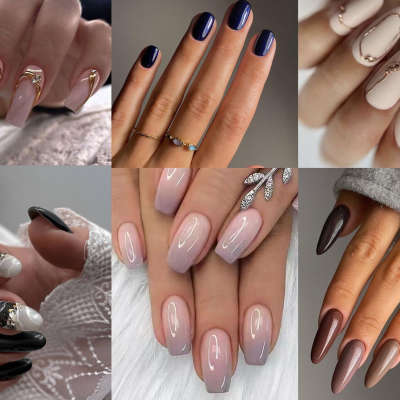Top 7 Fashion Rules That Have Become Outdated
As we open our closets, we see how classic fashion rules give way to creativity and individuality. In our time, bold experiments and breaking traditions become the key to a stylish image. Find out which of the familiar fashion rules should be left in the past.
1 May 2024
Remembering Old Fashion Rules
Rule 1: "Don't Mix Prints"
Rule 2: "Follow the Trends"
Rule 3: "Dress According to Your Body Type"
Rule 4: "Don't Wear White After Labor Day"
Rule 5: "Clothes Should Be Tailored to the Body"
Rule 6: "Jeans Are Only for the Kitchen"
Rule 7: "No Black and Brown Together"

Remembering Old Fashion Rules
In the world of fashion, nothing is eternal. What is considered a trend today may become outdated tomorrow, and vice versa. Let's recall the old rules that were once unquestionable laws in the world of style and fashion. Times change, and along with them, what we consider fashionable evolves. It's a process of continuous change and renewal that inevitably affects how we perceive and choose our style.
It used to be believed that fashion was something constant, imposed on us from above. However, today we see that it's just an illusion, and real fashion is the manifestation of individuality and self-expression through clothing. Past rules dictating what "can't be done" give way to new interpretations and freedom of experimentation.
Many of us remember how important it was to adhere to certain standards: not mixing different prints, choosing clothes according to body type, avoiding the combination of black and brown. These rules, seemingly defining our style and appearance, are increasingly being ignored in pursuit of freedom of self-expression and originality.
The evolution of fashion and style perception reflects changes in society and culture. Today, fashion is becoming more inclusive and diverse, reflecting a wide range of individual preferences and tastes. Opening our wardrobe, we see not only clothes but also a history of changes in our perceptions of style and beauty.
Thus, introducing the topic of old fashion rules is not only reminiscing about the past but also analyzing how changes in the world influence our view of style and fashion. Imagine what other changes may occur in the future and how they will affect how we dress and express ourselves through clothing.
Rule 1: "Don't Mix Prints"
In the world of fashion, conventional rules are constantly changing, and "Don't Mix Prints" is one of those that has ceased to be a strict law. Previously, such an approach to combining different patterns was considered a "bold experiment" that could ultimately look ridiculous. However, today's fashion trends push us towards bolder and more original solutions. Mixing prints is now perceived as a manifestation of style and individuality rather than a fashionable faux pas.
The technique of mixing prints provides endless opportunities for creativity in creating outfits. Instead of limiting ourselves with stereotypes and biases, fashion icons and designers nowadays actively encourage experimenting with patterns and textures. For example, combining a striped blazer with a floral dress or geometric prints with animal motifs - all of this is not only allowed but also welcomed.
It's important to understand that successful print mixing requires good taste and a sense of proportion. When choosing combinations of patterns, pay attention to the color scheme, scale, and style of the prints so that they complement each other harmoniously rather than compete with each other. Additionally, you can play with textures and fabric finishes to add interest and depth to the outfit.
Contemporary brands and designers actively promote the idea of freedom in choosing style and experimenting with clothing. This is reflected not only in fashion shows and collections but also in street style, where people boldly combine different prints to create unique looks. This trend is also supported in the mass-market sector, where you can find a wide selection of clothing with prints already harmoniously mixed.
In conclusion, the rule "Don't Mix Prints" now sounds like a limitation that restricts our creativity and individuality. In the world of modern fashion, there are no prohibitions, only opportunities for experimentation and self-expression through clothing.
Rule 2: "Follow the Trends"
Following trends in the fashion world was once a mandatory rule, but today's fashion trends are constantly changing. Submitting to fashion dictates is no longer the only way to create a stylish look. Today, fashion becomes more individualistic and diverse, reflecting a wide range of preferences and tastes. Emphasizing one's uniqueness and style becomes more important than simply following trends.
The fashion industry is constantly evolving, and what is trendy today may become outdated tomorrow. The desire to constantly stay on trend requires regularly updating one's wardrobe and closely following all fashion novelties. However, stylish individuals nowadays are increasingly choosing unique and original items, not conforming to accepted fashion dictates.
Instead of blindly following trends, modern fashionistas prefer to interpret them in their own way, incorporating what they truly like and what suits them into their style. Original outfits created based on bold combinations and eclectic solutions stand out in the crowd and distinguish themselves with their individuality.
Fashion trends are often dictated by major fashion houses and designers, but today the internet and social media allow everyone to express their preferences and influence fashion trends. Bloggers, influencers, and ordinary users actively share their outfits and inspire millions of people around the world.
In conclusion, the rule "Follow the Trends" becomes obsolete because today fashion becomes more individualistic and diverse, reflecting a wide range of individual preferences and tastes. It's important to stand out from the crowd, expressing one's uniqueness and style through clothing, rather than simply blindly conforming to fashion dictates.
Rule 3: "Dress According to Your Body Type"
Dressing according to your body type has long been considered an essential rule in the fashion world. The idea was that certain body types are better suited to certain styles and silhouettes of clothing. However, today we see that this rule is increasingly being broken as fashion trends become more inclusive and diverse. Modern designers and stylists actively support the idea that every woman has the right to choose a style she likes, regardless of her body type.
The concept of "body type" often leads to restricting clothing choices and creates a false idea of what an ideal figure should look like. Instead of conforming to beauty standards, modern women are increasingly choosing clothing that emphasizes their individuality and self-expression, rather than simply fitting certain body parameters.
Today, fashion is becoming more inclusive and democratic, reflecting the diversity of shapes and sizes of the female body. Designers create collections that are suitable for different body types, offering a variety of silhouettes, lengths, and styles. This allows every woman to find clothing that suits her best and makes her feel confident.
It's important to understand that style should not be limited by body type. Instead of adhering to strict rules, women should explore their style, experiment with different silhouettes and styles, and find what best accentuates their uniqueness and beauty.
Thus, the rule "Dress According to Your Body Type" becomes obsolete in the world of modern fashion, where the expression of individuality and self-expression through clothing is paramount. Every woman has the right to choose a style that suits her personal preferences and tastes, regardless of her body shape and size.
Rule 4: "Don't Wear White After Labor Day"
The rule "Don't Wear White After Labor Day" has been one of the most well-known and strict rules in the fashion world for many years. It was believed that white was a sign of the summer season and should only be worn until Labor Day, traditionally observed in the United States at the beginning of September. However, today, this rule is increasingly being broken as fashion trends become more free and diverse.
Modern designers and stylists actively support the idea that white can be suitable for any season and occasion. White clothing is not only a symbol of summer but also embodies freshness, lightness, and elegance, which can be relevant at any time of the year.
Traditional notions of fashion are gradually changing, and today, white is considered universal and classic, capable of being paired with various shades and accessories to create stylish and elegant looks.
One argument against the rule "Don't Wear White After Labor Day" is that in the modern world of fashion, there are no strict rules, and everyone has the right to self-expression and the choice of a style they like. White becomes a key element in the wardrobe of many women who appreciate its versatility and the ability to create diverse looks.
White is also perfect for special events and celebrations, such as weddings and festivities, where it symbolizes purity, innocence, and joy. This allows white clothing to be used not only in everyday life but also in special moments, making it an integral part of many women's wardrobes.
Ultimately, the rule "Don't Wear White After Labor Day" becomes obsolete in the modern fashion world, where individuality and freedom of self-expression are paramount. White becomes a universal symbol of elegance and style that can be relevant for any season and occasion.
Rule 5: "Clothes Should Be Tailored to the Body"
For a long time in the fashion world, there was a belief that clothes should be tailored to the body to accentuate its curves and create the perfect silhouette. However, today we see a shift in this rule as fashion trends become more diverse and inclusive. While clothing that fits snugly still has its place in the fashion world, fashionistas and designers now also appreciate loose silhouettes and oversized styles that offer more comfort and freedom of movement.
Modern fashion increasingly emphasizes the idea of comfort and self-expression, so the assertion that clothes must be tightly tailored to the body becomes less rigid. Many designers create collections featuring various silhouettes, from form-fitting to loose, so that everyone can choose what suits them best.
Clothing that hugs the body can be elegant and feminine, but it can also restrict movement and cause discomfort. In contrast, loose silhouettes and oversized designs offer more freedom and comfort, which is particularly relevant in everyday life and active lifestyles.
Today, many fashion icons and influential figures in the fashion world actively promote the idea of oversized and loose silhouettes, demonstrating that style and elegance can be combined with comfort and practicality. This underscores the trend towards diversity and individuality in fashion, where everyone has the right to choose a style that best suits their preferences and lifestyle.
Clothes should not only be stylish but also comfortable, so it's important to choose models that fit well and offer enough freedom and comfort. Ultimately, the rule "Clothes Should Be Tailored to the Body" ceases to be the only correct one in the modern fashion world, where comfort and self-expression through clothing are paramount.
Rule 6: "Jeans Are Only for the Kitchen"
For a long time, the rule "Jeans are only for the kitchen" was one of the most popular and strict rules in the fashion world. It was believed that jeans were inappropriate for special occasions and should be reserved only for everyday tasks such as housework or grocery shopping. However, today we see a shift in this rule as jeans become an integral part of stylish and elegant outfits.
Modern fashion is increasingly oriented towards comfort and practicality, so the restriction on using jeans only for household chores becomes less relevant. Jeans are not only a symbol of freedom and casualness but also an important wardrobe staple that can be successfully incorporated into various outfits.
Today, jeans can be seen not only on the streets or in cafes but also at various events, including parties, dates, and even business meetings. This underscores the change in perception of jeans as universal and stylish clothing that can be suitable for various situations and events.
It is important to understand that the choice of jeans and their style plays a key role in creating an outfit. Today, there are many different models and cuts of jeans that can be chosen based on individual preferences and style. From classic skinny jeans to stylish wide-leg trousers, jeans offer a wide selection for those who value comfort and style.
Clothing should reflect our personal vision of style and be an expression of our individuality. Instead of following strict rules, modern women are increasingly choosing items that make them feel confident and comfortable. Jeans become one of those items that help express our uniqueness and style.
Thus, the rule "Jeans are only for the kitchen" ceases to be relevant in the modern fashion world, where comfort and individuality are paramount. Jeans become an integral part of stylish and elegant outfits that can be successfully incorporated into various situations and events.
Rule 7: "No Black and Brown Together"
The rule "No black and brown together" has long been one of the strictest and most immutable in the fashion world. It was believed that combining these two colors was awkward and unsuitable for a stylish look. However, today we are witnessing a change in this rule, as fashion trends become more free and diverse.
Black and brown are two classic colors that can complement each other perfectly, creating elegant and stylish looks. Today, many designers and stylists actively use the combination of these colors in their collections, showing that it can be striking and fashionable.
One of the key points in successfully combining black and brown is the choice of shades. It is important to select colors that harmonize with each other and create a unified stylish look. For example, you can combine black with dark brown or chocolate brown for a more restrained and classic look, or black with light brown for a fresher and brighter look.
The combination of black and brown allows you to create a look with character and individuality that attracts attention and looks stylish and modern. This underscores the change in perception of colors in fashion, where not only strict adherence to rules is valued, but also creativity and experimentation.
Today, many fashion icons and influential personalities in the fashion world actively support the idea of combining black and brown, demonstrating that this combination can be stylish and elegant. This helps to break stereotypes and established rules in fashion, opening up new opportunities for creativity and self-expression.
Thus, the rule "No black and brown together" ceases to be relevant in the modern fashion world, where individuality and style are paramount. The combination of these two colors is becoming increasingly popular and fashionable, reflecting changes in perceptions of fashion and style.





